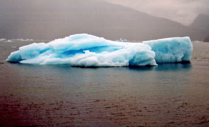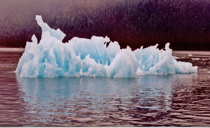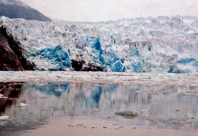
Mitkof Island & Vicinity Map
Navigation
We arrive
Kenai Peninsula
Glacier Bay
Juneau
Glacier Gardens
A brief detour
Aboard the Sheltered Seas
Petersburg to Ketchikan
Last Leg
Aboard the Sheltered Seas
We had decided that a short package tour would help us see Alaska, particularly the Inland Passage so Bob booked us on a gem on the Sheltered Seas, a 90-foot, 70-passenger "day yacht" operated by Cruise West. Our southbound package included a hotel stay in Juneau the night before departure, the three-day Inside Passage cruise, staying two nights in Petersburg on Mitkof Island, and a hotel stay after arrival in Ketchikan. The small size of the Sheltered Seas allows us to take routes and see glaciers unavailable to the large cruise ships.Our captain did an excellent job pushing us through an ice field to get within 3/4 of a mile to South Sawyer Glacier on Tracy Arm, the first boat to do so since last July. Seal mothers whelp on ice floes to avoid orcas eating their young. We saw many such pairs as we headed toward South Sawyer. The seals make little noise. We both got great pictures including one of a seal pup peeking out of a hole in the ice.
The oldest glacier ice has an incredible blue color, the results of compressed water molecules. The blue color even remains in the larger icebergs and it's quite fascinating. As the icebergs float, the lapping water carves out unusual patterns; the bergs can flip exposing new areas to the water’s knife. Lovely shapes emerge. I kept thinking I had enough pictures of ice but then, the next glacier or berg would be so unique, I would take more. Of course, the photos don't really convey the immensity; South Sawyer is 250' high. We made it through more ice floes to see LeConte, the southernmost tidewater glacier in North America.
Along the Inland Passage on various days, we saw humpbacks, orcas and a pod of Dahl porpoises who kept us amused for over twenty minutes, surfing along our bow. Dahls are favorite food for orcas and survive by being able to swim 33 mph; orcas can do about 30 mph. Our boat was going about 10 mph so the porpoises had no trouble keeping up with us.
The first humpback we saw (in Frederick Sound) was feeding with his mouth open; it’s incredible to think these large mammals feed on the smallest of life, straining the water through their baleen to capture microcosms about the breadth of a hair and maybe half an inch long.
We saw our second haulout of Stellar sea lions at Easterly Island; these massive creatures are quite noisy, like a gaggle of teenagers with cell phones. We were told sea lions can walk on their hind flippers, seals cannot.
The naturalists on board both boats were excellent; we learned a great deal about the birds of Alaska, the forests and plant life, and about the Tlingit, People of the Tides. They lived quite an easy life thanks to the riches of the waters and wisely used the tides. They built heart-shaped traps out of wooden stakes that allowed the fish to swim in but left them trapped as the tide went out. Bob saw an old one in Petersburg. As it was explained, “When the tide is out, the table is set.” Seaside inhabitants of the Orkneys would call it “ebb meat.”
Natives of Alaska include the Aleuts and Inuits (who have been called Eskimos) and a number of sub-tribes of the Athabaskan Native Americans. They have formed corporations to take advantage of oil money guaranteed them with the pipeline. The Tlingit were most prominent on our trip, as they have entered the hospitality industries. We stayed in their hotels. They run the Mt. Roberts tram. Our guide on the tram treated us to a Tlingit song on the ride down.
Most of our fellow passengers on The Sheltered Seas were adults; the few teens amused themselves with card games between wildlife sightings. Most of the adults seemed to be school teachers, retired teachers, all active independent travelers, including one family of seven (elderly couple and five grown children). We had all been to many of the same places over the years. The Galapagos Islands appeared to be a popular next destination.
The mudflats outside Wrangell had at least 200 bald eagles lined up on the shore waiting for salmon; Alaska has been short of rain and some of the creeks are low; it was explained to me that the salmon were not yet heading upstream, therefore. Certainly when they do, there will be a lot of people, eagles, bears and others waiting to greet them.
Virtually all of southeast Alaska, and our cruise, is in the Tongass National Forest; our naturalist reminded us that while the shores are dense with trees, much of the interior is less so. Everyone was quite circumspect about the timber industry, global warming and other political topics unless you spoke to them in private.
Along the cruise, we saw black-tailed deer; they are very small (about 3 feet high, 120 pounds) and usually live only a few years: grizzly bear hors d’oerves on the hoof.
Wherever we went, we enjoyed the birds, seeing arctic loons, tundra swans, eider ducks, scoters, horned puffins and tufted puffins (which JS adored), cormorants, oystercatchers, arctic terns, gulls of all kinds, bald eagles, hummingbirds, steller’s jays, ravens, crows, magpies, robins, a pair of varied thrushes, warblers and common redpoll.

At LeConte Glacier

Our vessel, the Sheltered Seas

Seal mom and pup

Sea hauling onto ice floe

More seals on ice

Blue berg in Holkam Bay by Tracy Arm

This blue berg came of LeConte



